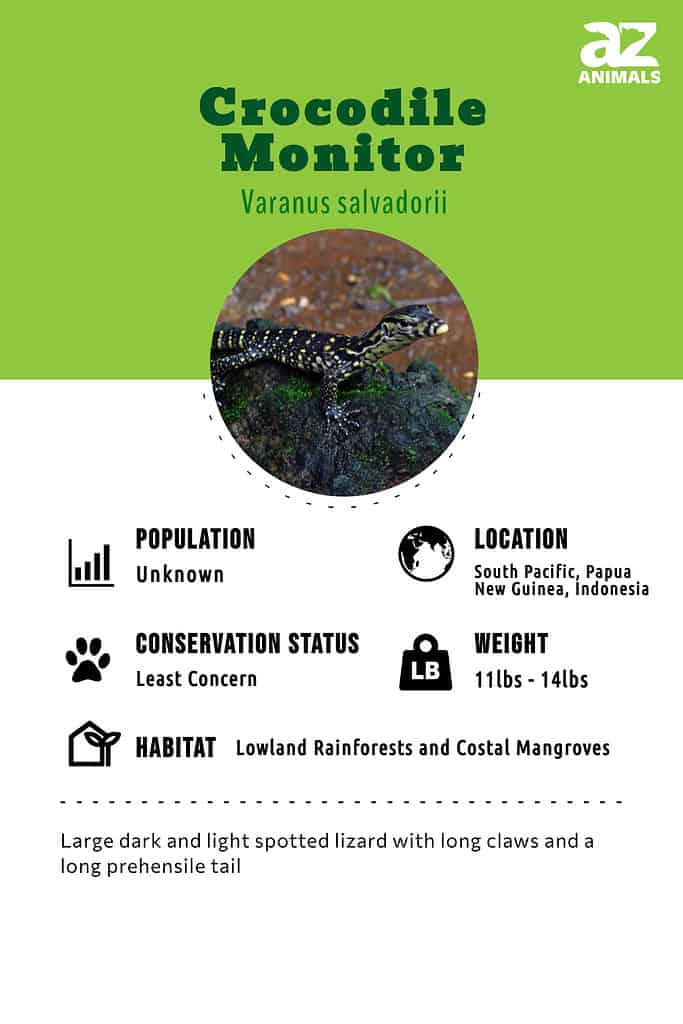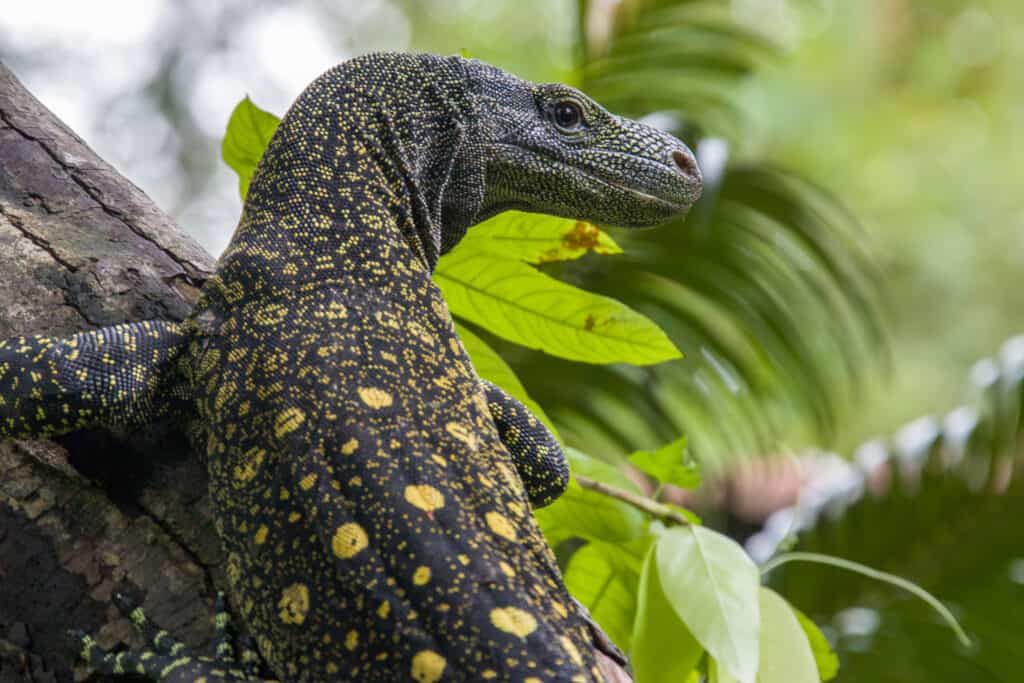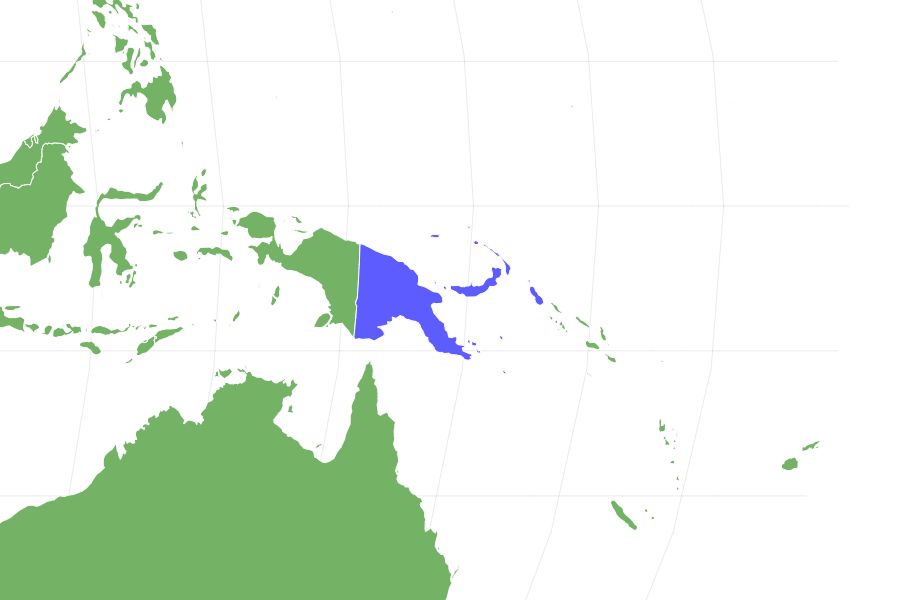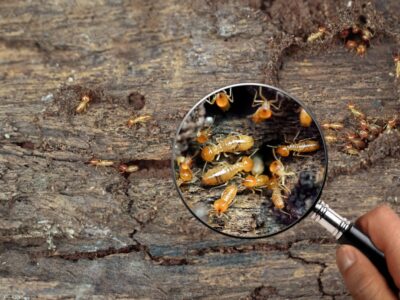Crocodile Monitor
Varanus salvadorii
Its tail is twice the length of its body.
Advertisement
Crocodile Monitor Scientific Classification
- Kingdom
- Animalia
- Class
- Reptilia
- Order
- Squamata
- Family
- Varanidae
- Genus
- Varanus
- Scientific Name
- Varanus salvadorii
Read our Complete Guide to Classification of Animals.
Crocodile Monitor Conservation Status
Crocodile Monitor Facts
- Prey
- birds, small reptiles, eggs, fish, rats, quail, dead animals
- Group Behavior
- Solitary
- Fun Fact
- Its tail is twice the length of its body.
- Biggest Threat
- deforestation, poaching
- Most Distinctive Feature
- very long tail
- Other Name(s)
- Papuan monitor, Salvadori's monitor
- Gestation Period
- 155-246 days
- Habitat
- Forests, Coastal Mangrove Swamps,
- Lifestyle
- Diurnal
- Solitary
- Type
- Reptilia
- Common Name
- Crocodile Monitor
- Number Of Species
- 1
- Location
- New Guinea
- Group
- solitary
View all of the Crocodile Monitor images!
The Crocodile monitor uses its multi-purpose, remarkably long tail to whip threats and counterbalances itself while climbing.
Arguably the most impressive and intimidating lizard in the world, Varanus salvadorii is regarded as the ultimate pet monitor. They are also called crocodile monitors, Salvadori’s monitors, or Papuan monitors. Sometimes, they are called Tree crocodiles because of their highly arboreal nature, since they are found in the tropical forests of the island of New Guinea. They feed on birds, mammals, small reptiles, and any dead animal they come across. V. salvadorii is a very large species compared to other monitor lizards, with only the Komodo dragon and the Asian water monitor beating it to the top spot. However, fully-grown crocodile monitors edge over the Komodo dragons in length.
5 Crocodile Monitor Facts

- The similarity of crocodile monitors to a crocodile pretty much stops at the name. They got the name because their bite is similar to that of a crocodilian.
- They are known for their remarkable long tail, which is twice as long as the body.
- Their long claws, svelte bodies, and prehensile tails make crocodile monitors dexterous climbers.
- Unlike most monitors, Salvador’s monitors have large, flat, serrated teeth that are better adapted to capture and tear into their prey.
- Salvadori’s monitors are mostly inaccessible in the wild and difficult to breed in captivity; hence the limited knowledge about them.
Crocodile Monitor Scientific Name
V. salvadorii is also called the Crocodile monitor, Salvadori’s monitor, or Papuan monitor. They are not to be confused with the South-East Asian water monitor (Varanus salvator) which has a similar scientific name. In fact, V. salvadorii is the only species in the Papusaurus subgenus and does not have any synonyms or recognizable subspecies. Like most monitors of the Varaniidae family, Papuan monitors have long necks and tails. The name Varanus comes from the Arabic word “waral,” meaning lizard. The specific name “salvadorii” was derived from the Latinization of an Italian ornithologist, Tommaso Salvadori, who worked in New Guinea.
Crocodile Monitor Appearance and Behavior
Like most monitors of the Varanidae order, crocodile monitors have long necks and non-autonomous tails. They have yellow, white, or green spots and stripes on their primarily black body. They are some of the longest lizards but generally only weigh from 5 to 6.38 kg (11.0 to 14.1 lb), with the Komodo dragon and Asian water monitor being bigger monitors. Adult Crocodile Monitors average 2.1m – 2.7m (82.7in – 106.3in) in length. However, lengths of up to 5m (96 inches) have been reported. This gives them the spot of being the world’s longest monitor lizard. They also have a uniquely bulged snout with a high head.
They are famous for their multi-purpose long tail, which they use for prehensile gripping and to defend themselves from threats. Being one of the few highly arboreal members of the Varanidae lizards, they enjoy climbing trees. However, they prefer to sleep on the ground or underwater.
They are generally solitary and avoid human contact. Also, they are diurnal, aggressive, partially venomous, and may bite, causing an infection. Crocodile monitors also use their sharp, straight teeth to defend themselves and tear into their prey.
The South-East Asian water monitor (V. salvator) and the Santa Isabel monitor(V. spinulosus) are similar species but have a shorter and more pointed snout.

A full-grown crocodile monitor may reach 8.86 feet in length and weigh as much as 198 pounds.
©Danny Ye/Shutterstock.com
Crocodile Monitor Habitat
These monitor lizards naturally inhabit the high and low canopies of the lowland rainforests. They are also found in the coastal mangrove swamps and riparian woodlands near water. They prefer to be undisturbed by humans and also spend a lot of time climbing trees. In fact, Salvadori’s monitors are difficult to breed in captivity, and their inaccessible habitat makes it difficult to study them in the wild.
Native to a large island in Papua New Guinea, these long monitor lizards are being threatened by the hunting and deforestation activities of the native people.
Crocodile Monitor Evolution and History
Around 40 million years ago (mya) the Asian Monitor Varanus family most likely migrated down to modern-day Indonesia via various land bridges. Around 15 mya various other Varanus lizards moved up from modern-day Australia via changes in tectonic plates to Papa New Guinea and through various evolution and cross-breeding the Crocodile Monitor emerged alongside the Lace Monitor (Varanus varius) and the Komodo dragon (Varanus komodoensis).
Countries Where the Crocodile Monitor is Found
Crocodile Monitor Predators and Threats
There is sparse information regarding the major diet of the Salvadori lizards. However, they are considered apex predators that can feed on any animal that they can overpower.
What Does the Crocodile Monitor Eat?
Crocodile monitors feed on invertebrates as juveniles and then feed on vertebrates when they become adults. They have been reported to eat birds, small mammals, fish, eggs, carrion, and some vegetation. Crocodile monitors have also been seen eating chicks, quail, mice, and small rats. There are also reports that they may be scavengers. It’s important to note that there is limited information regarding their feeding habits in the wild.
What Eats Crocodile Monitors?
Crocodile monitors are one of the few cold-blooded apex predators with no known animal predators. However, humans and human activities threaten their existence.
Salvadori’s monitors are hunted for their skin and meat. They are listed under CITES Appendix II. No live specimens are allowed to be exported from Papua New Guinea. In Indonesia, however, these creatures are not protected. Also, the European Union has since 1998 stopped the importation of wild-caught crocodile monitors from Indonesia.
Reproduction, Babies, and Lifespan
Female crocodile monitors sexually mature at about two years of age, while the males take up to three years. Reproduction is sexual by internal fertilization and may occur throughout the year. However, in high latitudes, Salvadori’s monitors may prefer mating at the beginning of spring or autumn.
There are up to three clutches per year with 4 – 12 eggs. Like other varanid lizards, crocodile monitors have long incubation periods ranging between 155 and 251 days at temperatures between 27 and 30.5 degrees Celsius. Their hatchlings may reach up to 18 inches (46 cm) and weigh approximately 60 g (2.12 oz).
While the lifespan in the wild is largely unknown, these beautiful monitors have been reported to live up to 20 years in confinement.
Population
There is limited information regarding the population trends of these large Varanus species. Currently, the ICUN Red List ranks the Crocodile Monitor with a ‘least concern’ rating. However, active hunting of the crocodile monitor for its meat and skin puts the species’ population at risk.
Similar Animals to the Crocodile Monitor
- Komodo Dragon (V. komodoensis): Regarded as the largest monitor lizard. This enormous reptile is an apex predator found only on Indonesian islands and is also remarkably long.
- The South-East Asian Water Monitor (V. salvator): Found in South-East Asia, this monitor has a shorter and more pointed snout.
- The Santa Isabel Monitor (V. spinulosus): They are also similar to the crocodile monitors but with a shorter and more pointed snout.
- View all other types of Monitor lizards here.
Crocodile Monitor FAQs (Frequently Asked Questions)
Are crocodile monitors friendly?
Crocodile monitors are naturally aggressive monitor lizards that prefer to avoid human contact. They are apex predators that feed on birds, small reptiles, fish, eggs, etc. They are rarely successfully bred in captivity, and there are claims that you may build trust by feeding them.
Are crocodile monitors venomous?
Like other monitor lizards, crocodile monitors are said to be partially venomous. Their bites have been reported to cause an infection that may be fatal if not taken care of.
How big does a crocodile monitor get?
Crocodile monitors are a very large species, just behind the Asian water monitor and the Komodo dragon as the largest. They are regarded as the longest monitor lizard, with a total length reaching over 8 ft (2.4 m). They also weigh up to 20 kg (44 lbs).
Do crocodile monitors bite?
Crocodile monitors are aggressive lizards and may bite if adequate care is not taken. Researchers claim the bite is partially venomous and may cause an infection.
Why are they called crocodile monitors?
They are called crocodile monitors because of the similarity of their bite to a crocodilian’s.
Thank you for reading! Have some feedback for us? Contact the AZ Animals editorial team.
Sources
- Wikipedia, Available here: https://en.wikipedia.org/wiki/Varanus_salvadorii
- National Zoo, Available here: https://nationalzoo.si.edu/animals/crocodile-monitor#:~:text=Crocodile%20monitors%20are%20large%2C%20arboreal%20(or%20tree%2Ddwelling),like%20a%20whip%20for%20defense
- Sea World, Available here: https://seaworld.org/animals/facts/reptiles/crocodile-monitor/


















